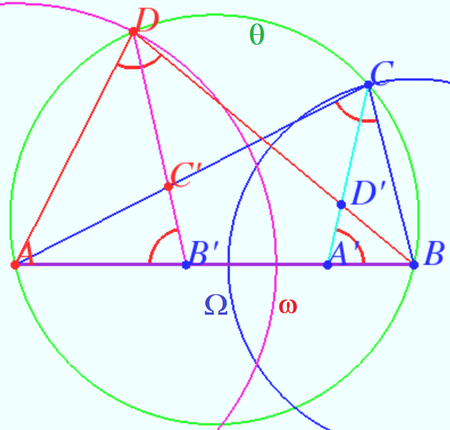Difference between revisions of "2019 USAMO Problems/Problem 2"
(→See also) |
(→Solution 2) |
||
| Line 34: | Line 34: | ||
==Solution 2== | ==Solution 2== | ||
| − | + | [[File:2019 USAMO 2.png|450px|right]] | |
Let <math>\omega</math> be the circle centered at <math>A</math> with radius <math>AD.</math> | Let <math>\omega</math> be the circle centered at <math>A</math> with radius <math>AD.</math> | ||
Let <math>\Omega</math> be the circle centered at <math>B</math> with radius <math>BC.</math> | Let <math>\Omega</math> be the circle centered at <math>B</math> with radius <math>BC.</math> | ||
We denote <math>I_\omega</math> and <math>I\Omega</math> inversion with respect to <math>\omega</math> and <math>\Omega,</math> respectively. | We denote <math>I_\omega</math> and <math>I\Omega</math> inversion with respect to <math>\omega</math> and <math>\Omega,</math> respectively. | ||
| − | < | + | <cmath>B'= I_\omega (B), C'= I_\omega (C), D = I_\omega (D) \implies</cmath> |
| − | < | + | <cmath>AB' \cdot AB = AD^2, \angle ACB = \angle AB'C'.</cmath> |
| − | Let <math>\theta</math> be the circle <math>ABCD. | + | <cmath>A'= I_\Omega (A), D'= I_\Omega (D), C = I_\omega (C) \implies</cmath> |
| − | <math>I_\Omega (\theta) = A'D'C,</math> straight line, therefore < | + | <cmath>AA' \cdot AB = BC^2, \angle BDA = \angle BA'D'.</cmath> |
| − | <math>ABCD</math> is cyclic <math>\implies \angle BA'C = \angle AB'D.</math> | + | Let <math>\theta</math> be the circle <math>ABCD.</math> |
| + | |||
| + | <math>I_\omega (\theta) = B'C'D,</math> straight line, therefore <cmath>\angle AB'C' = \angle AB'D' = \angle ACB.</cmath> | ||
| + | <math>I_\Omega (\theta) = A'D'C,</math> straight line, therefore | ||
| + | <cmath>\angle BA'D' = \angle BA'C = \angle BDA.</cmath> | ||
| + | <math>ABCD</math> is cyclic <math>\implies \angle BA'C = \angle AB'D.</math> | ||
| + | <math>AB' + BA' = \frac {AD^2 + BC^2 }{AB} = AB \implies</math> points <math>A'</math> and <math>B'</math> are coincide. | ||
| + | |||
| + | Denote <math>A' = B' = Q \in AB.</math> | ||
| + | |||
| + | Suppose, we move <math>P</math> from <math>A</math> to <math>B.</math> Then <math>\angle AQD</math> decreases monotonically, <math>\angle AQC</math> increases monotonically. So, there is only one point where <math>\angle AQD = \angle BQC \implies P = Q.</math> | ||
| + | <math>B = I_\omega (P), D' = I_\omega (D'), C' = I_\omega (C), A = I_\omega (\infty) \implies I_\omega (CD'P) = AC'D'B </math> is cyclic. | ||
| + | <math>\angle ACD = \angle ABD = \angle CC'D \implies C' D' || CD \implies C'D'CD</math> is trapezoid. | ||
| + | It is known that the intersection of the diagonals, intersection point of the lines containing the lateral sides of the trapezoid and the midpoints of two parallel sides are collinear. | ||
| + | '''vladimir.shelomovskii@gmail.com, vvsss''' | ||
==See also== | ==See also== | ||
{{USAMO newbox|year=2019|num-b=1|num-a=3}} | {{USAMO newbox|year=2019|num-b=1|num-a=3}} | ||
Revision as of 11:06, 16 September 2022
Contents
Problem
Let ![]() be a cyclic quadrilateral satisfying
be a cyclic quadrilateral satisfying ![]() . The diagonals of
. The diagonals of ![]() intersect at
intersect at ![]() . Let
. Let ![]() be a point on side
be a point on side ![]() satisfying
satisfying ![]() . Show that line
. Show that line ![]() bisects
bisects ![]() .
.
Solution
Let ![]() . Also, let
. Also, let ![]() be the midpoint of
be the midpoint of ![]() .
Note that only one point
.
Note that only one point ![]() satisfies the given angle condition. With this in mind, construct
satisfies the given angle condition. With this in mind, construct ![]() with the following properties:
with the following properties:
(1) ![]()
(2) ![]()
Claim: ![]()
Proof:
The conditions imply the similarities ![]() and
and ![]() whence
whence ![]() as desired.
as desired. ![]()
Claim: ![]() is a symmedian in
is a symmedian in ![]()
Proof:
We have
 as desired.
as desired. ![]()
Since ![]() is the isogonal conjugate of
is the isogonal conjugate of ![]() ,
, ![]() . However
. However ![]() implies that
implies that ![]() is the midpoint of
is the midpoint of ![]() from similar triangles, so we are done.
from similar triangles, so we are done. ![]()
The problems on this page are copyrighted by the Mathematical Association of America's American Mathematics Competitions. 
Solution 2
Let ![]() be the circle centered at
be the circle centered at ![]() with radius
with radius ![]() Let
Let ![]() be the circle centered at
be the circle centered at ![]() with radius
with radius ![]() We denote
We denote ![]() and
and ![]() inversion with respect to
inversion with respect to ![]() and
and ![]() respectively.
respectively.
![]()
![]()
![]()
![]() Let
Let ![]() be the circle
be the circle ![]()
![]() straight line, therefore
straight line, therefore ![]()
![]() straight line, therefore
straight line, therefore
![]()
![]() is cyclic
is cyclic ![]()
![]() points
points ![]() and
and ![]() are coincide.
are coincide.
Denote ![]()
Suppose, we move ![]() from
from ![]() to
to ![]() Then
Then ![]() decreases monotonically,
decreases monotonically, ![]() increases monotonically. So, there is only one point where
increases monotonically. So, there is only one point where ![]()
![]() is cyclic.
is cyclic.
![]() is trapezoid.
It is known that the intersection of the diagonals, intersection point of the lines containing the lateral sides of the trapezoid and the midpoints of two parallel sides are collinear.
vladimir.shelomovskii@gmail.com, vvsss
is trapezoid.
It is known that the intersection of the diagonals, intersection point of the lines containing the lateral sides of the trapezoid and the midpoints of two parallel sides are collinear.
vladimir.shelomovskii@gmail.com, vvsss
See also
| 2019 USAMO (Problems • Resources) | ||
| Preceded by Problem 1 |
Followed by Problem 3 | |
| 1 • 2 • 3 • 4 • 5 • 6 | ||
| All USAMO Problems and Solutions | ||










